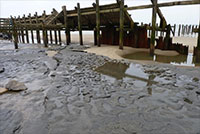Homo antecessor

Reconstruction of Homo antecessor
This species was living in Spain by about 800,000 years ago, making them some of the earliest humans in Europe.
The evidence of footprints and tools discovered in the UK raise the intriguing possibility that they may have been the first human species to venture into Britain.
Fossil evidence

Incomplete skull of Homo antecessor discovered at Gran Dolina in Atapuerca, Spain. Courtesy of José-Manuel Benito.
The species Homo antecessor is currently only known from one site: Gran Dolina, Atapuerca in Spain.
The fragmentary remains are dated to about 800,000 years old and are thought to belong to six individuals. Cut marks on the bones suggest that these humans may have been cannibalised.
The best preserved of the Gran Dolina specimens - the partial skull of a child - shows a unique combination of features compared to other Homo species, including a heavy brow ridge typical of older species such as H. erectus, but a more modern looking mid-face and possibly a larger brain. The teeth and lower jaw also show a mix of older and more recent traits. It is difficult to know exactly how this person would have looked had they reached maturity.
The first Britons?

Coastal erosion revealed these 900,000-year-old footprints at Happisburgh, Norfolk in 2013.
The dating of stone tools found at Happisburgh, Norfolk, in the UK suggests that Homo antecessor may have been the first human species to occupy Britain, around 900,000 years ago.
Coastal erosion at Happisburgh in May 2013 revealed footprints that date to around the same time. A small group of humans left behind these traces as they walked along the mudflats of a large river estuary. Their tracks quickly became buried by tidal sediments and were preserved.
Footprint analysis suggests they were made by a small group of young and adult humans, who were about 0.9-1.7m tall, correlating with estimates for Homo antecessor body size.